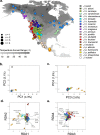Temperature heterogeneity correlates with intraspecific variation in physiological flexibility in a small endotherm
- PMID: 34285216
- PMCID: PMC8292308
- DOI: 10.1038/s41467-021-24588-6
Temperature heterogeneity correlates with intraspecific variation in physiological flexibility in a small endotherm
Abstract
Phenotypic flexibility allows individuals to reversibly modify trait values and theory predicts an individual's relative degree of flexibility positively correlates with the environmental heterogeneity it experiences. We test this prediction by integrating surveys of population genetic and physiological variation with thermal acclimation experiments and indices of environmental heterogeneity in the Dark-eyed Junco (Junco hyemalis) and its congeners. We combine field measures of thermogenic capacity for 335 individuals, 22,006 single nucleotide polymorphisms genotyped in 181 individuals, and laboratory acclimations replicated on five populations. We show that Junco populations: (1) differ in their thermogenic responses to temperature variation in the field; (2) harbor allelic variation that also correlates with temperature heterogeneity; and (3) exhibit intra-specific variation in thermogenic flexibility in the laboratory that correlates with the heterogeneity of their native thermal environment. These results provide comprehensive support that phenotypic flexibility corresponds with environmental heterogeneity and highlight its importance for coping with environmental change.
© 2021. The Author(s).
Conflict of interest statement
The authors declare no competing interests.
Figures



References
-
- Piersma T, Drent J. Phenotypic flexibility and the evolution of organismal design. Trends Ecol. Evolution. 2003;18:228–233. doi: 10.1016/S0169-5347(03)00036-3. - DOI
-
- Piersma, T. & van Gils, J. A. The Flexible Phenotype: A Body-centred Integration of Ecology, Physiology, and Behaviour (Oxford Univ. Press, 2011).
-
- Moran NA. The evolutionary maintenance of alternative phenotypes. Am. Naturalist. 1992;139:971–989. doi: 10.1086/285369. - DOI
Publication types
MeSH terms
LinkOut - more resources
Full Text Sources

